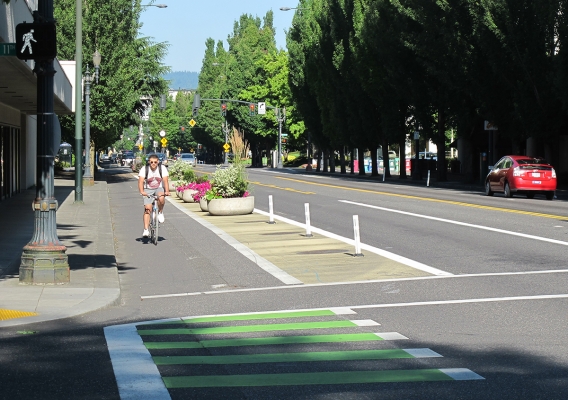Research reveals perceptions, safety and use of protected bike lanes

A research study released Monday by the National Institute for Transportation and Communities program offers the most comprehensive evaluation of protected bicycle lanes to date. The study, “Lessons from the Green Lanes: Evaluating Protected Bike Lanes in the U.S.,” examines recently installed protected bike lanes in five of the six founding PeopleForBikes Green Lane Project cities and provides the scientific basis for decisions that could improve bicycling in cities across the United States.
Protected bike lanes, sometimes called cycle tracks, are on-street lanes separated from traffic by curbs, planters, parked cars or posts to help organize the street and make riding a bike appealing for people of all ages and abilities. Because protected bike lanes are relatively new to the U.S., little academic research has existed to help leaders evaluate the risks and rewards of the investment in putting the facilities on the ground.
This study provides definitive evidence that people feel safe riding in protected lanes and that people traveling by car or foot also support building more protected lanes to separate bicycles and automobiles. It also provides insight on the safety, use and economic effect of protected lanes.
THE METHODOLOGY: FIVE CITIES
Researchers visited each of the five participating cities — Austin, Texas; Chicago; Portland, Oregon; San Francisco; and Washington, DC — and selected one to two protected bike lanes to study in each city. They set up cameras at two to three locations on each protected lane to gather data including bicycle counts and conflicts. They analyzed 168 hours of video where 16,393 bicyclists and 19,724 turning and merging vehicles were observed.
Research team members set up a rigorous video review process to ensure consistency and limit bias, spot-checking video reviewers and distributing their assignments. Regarding bicycle-vehicle interactions, no fewer than three team members reviewed each precautionary avoidance maneuver caught on video.
Researchers also mailed up to 2,000 surveys to residents living near each study site. They stopped cyclists – up to 900 in each city – and asked them to complete surveys as well. About a quarter of residents and a third of cyclists contacted completed the surveys.
The surveys drew from the researchers’ past surveys of protected bike lanes in Portland and Washington, D.C. The research team refined the surveys using input from one pilot survey conducted in a Portland State University survey methods course and another using transportation students. Staff members from each participant city reviewed the surveys and gave input that researchers incorporated.
Participating cities made traffic-count data available from before the protected lanes were installed for comparison. Post-installation counts used a combination of city counts and video review tallies.
THE KEY FINDINGS
- INCREASED RIDERSHIP: Researchers found that bicycle ridership increased on all the new studied streets, with an average increase of 72 percent. Some people said they cycle more in general because of the new lanes. Some said they would have taken another mode of transportation, such as driving or transit, or used another route if the protected lane hadn’t been there.
- FEELS SAFER: Cyclists said it feels safer to bicycle on the new facilities and all categories of road users said the safety of cycling on the street had increased. Perceptions of the effect on the safety of walking and driving on the street were mixed.
- IS SAFER: In the 144 hours of video analyzed for safety, with nearly 12,900 bicycles through the intersections, no collisions or near collisions were observed. This included both intersections with turn lanes and those with bicycle-specific traffic signals.
- PHYSICAL BARRIERS INCREASE LIKELIHOOD OF BIKING: People classified as “interested but concerned” in cycling had the highest perception of improved safety. This group, often the target of cycling-promotion efforts, indicated overwhelming support for separating bikes from cars. Of the “interested but concerned,” 85 percent of respondents indicated they would be more likely to cycle if a barrier separated cars and bikes.
- DRIVERS' PERCEPTION: Drivers thought traffic became more predictable and that fewer bicycles were mixed with motor-vehicle traffic. Most drivers said congestion and drive time didn’t change; among those who did, more people thought it got worse than better. A large minority thought parking got worse, even at sites where the number of spots stayed the same or increased.
- OVERALL SUPPORT: Overall, large majorities of all road users supported adding more protected lanes. Of people living near protected bike lanes, 76 percent support adding the lanes in additional locations, whether they use them or not.
- INTUITIVE INFRASTRUCTURE: Researchers found that people understand how to use the new protected lanes and what to do at intersections. Because the studied cities took different approaches to intersections, where automobiles and bicycles mix, the response of road users varied. Still, large majorities of cyclists felt safe going through all types of intersection design.
The NITC research team was led by Christopher Monsere, Jennifer Dill, Nathan McNeil and Kelly Clifton, with graduate students Nick Foster and Tara Goddard. Funding for the project was provided by NITC, a U.S. Department of Transportation university transportation center; the Summit Foundation and PeopleForBikes, with in-kind support from the five cities.
“This study fills a critical gap in the research and can influence national guidance on protected bike lanes,” Monsere said. “Policymakers can look to this research to see how they could best use protected bike lanes to meet their mobility, safety and economic goals.”
“The timing is great,” said Martha Roskowski, vice president of local innovation for People for Bikes. “The surge of interest in protected bike lanes in cities and towns across the country is being matched by agency work to better understand, refine and standardize the designs. We are delighted to have helped fund this important and rigorous project.”
The final report is available for download here: Lessons from the Green Lanes Final Report (PDF).
